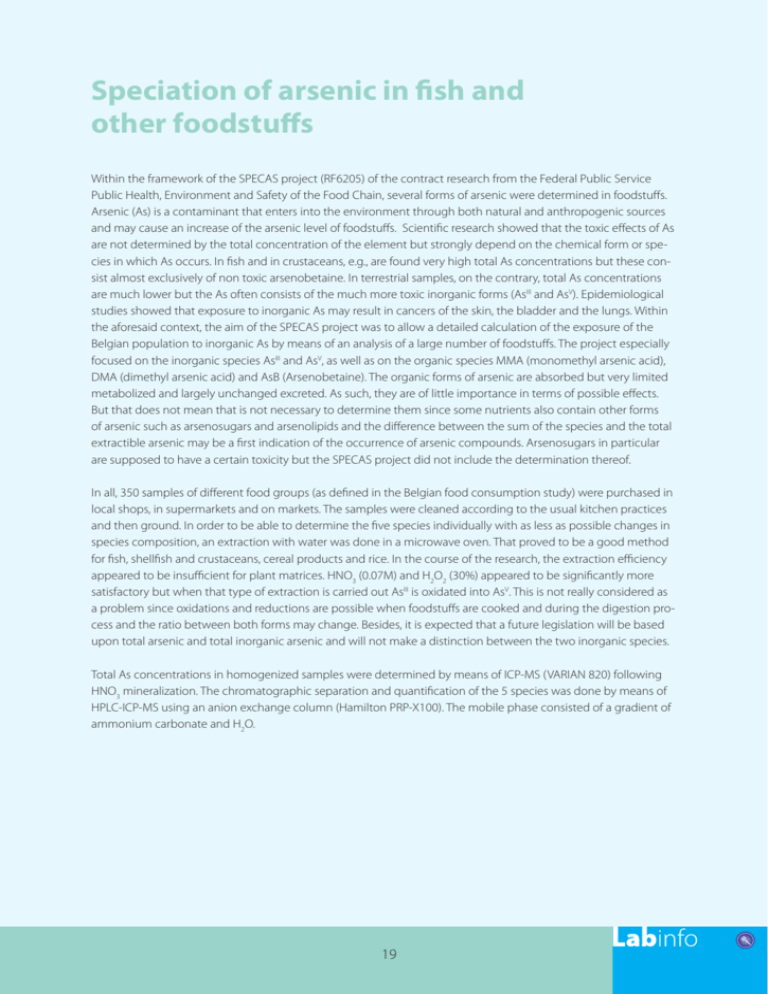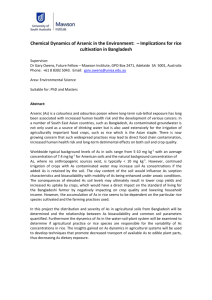Speciation of arsenic in fish and other foodstuffs
advertisement

Speciation of arsenic in fish and other foodstuffs Within the framework of the SPECAS project (RF6205) of the contract research from the Federal Public Service Public Health, Environment and Safety of the Food Chain, several forms of arsenic were determined in foodstuffs. Arsenic (As) is a contaminant that enters into the environment through both natural and anthropogenic sources and may cause an increase of the arsenic level of foodstuffs. Scientific research showed that the toxic effects of As are not determined by the total concentration of the element but strongly depend on the chemical form or species in which As occurs. In fish and in crustaceans, e.g., are found very high total As concentrations but these consist almost exclusively of non toxic arsenobetaine. In terrestrial samples, on the contrary, total As concentrations are much lower but the As often consists of the much more toxic inorganic forms (AsIII and AsV). Epidemiological studies showed that exposure to inorganic As may result in cancers of the skin, the bladder and the lungs. Within the aforesaid context, the aim of the SPECAS project was to allow a detailed calculation of the exposure of the Belgian population to inorganic As by means of an analysis of a large number of foodstuffs. The project especially focused on the inorganic species AsIII and AsV, as well as on the organic species MMA (monomethyl arsenic acid), DMA (dimethyl arsenic acid) and AsB (Arsenobetaine). The organic forms of arsenic are absorbed but very limited metabolized and largely unchanged excreted. As such, they are of little importance in terms of possible effects. But that does not mean that is not necessary to determine them since some nutrients also contain other forms of arsenic such as arsenosugars and arsenolipids and the difference between the sum of the species and the total extractible arsenic may be a first indication of the occurrence of arsenic compounds. Arsenosugars in particular are supposed to have a certain toxicity but the SPECAS project did not include the determination thereof. In all, 350 samples of different food groups (as defined in the Belgian food consumption study) were purchased in local shops, in supermarkets and on markets. The samples were cleaned according to the usual kitchen practices and then ground. In order to be able to determine the five species individually with as less as possible changes in species composition, an extraction with water was done in a microwave oven. That proved to be a good method for fish, shellfish and crustaceans, cereal products and rice. In the course of the research, the extraction efficiency appeared to be insufficient for plant matrices. HNO3 (0.07M) and H2O2 (30%) appeared to be significantly more satisfactory but when that type of extraction is carried out AsIII is oxidated into AsV. This is not really considered as a problem since oxidations and reductions are possible when foodstuffs are cooked and during the digestion process and the ratio between both forms may change. Besides, it is expected that a future legislation will be based upon total arsenic and total inorganic arsenic and will not make a distinction between the two inorganic species. Total As concentrations in homogenized samples were determined by means of ICP-MS (VARIAN 820) following HNO3 mineralization. The chromatographic separation and quantification of the 5 species was done by means of HPLC-ICP-MS using an anion exchange column (Hamilton PRP-X100). The mobile phase consisted of a gradient of ammonium carbonate and H2O. 19 The total arsenic content in the seafish analysed ranged from 630 µg kg-1 (salmon) to 25095 µg kg-1 (plaice) and in crustaceans and shellfish from 104 µg kg-1 (scampi) to 16908 µg kg-1 (crab). Freshwater fish contain less arsenic and the contents range from 30 µg kg-1 (eel) to 1702 µg kg-1 (trout). In crayfish the contents range from 126 to 171 µg kg-1. In general, the inorganic arsenic content in seafish is less than 1 % and the major part of the arsenic consists of arsenobetaine (AsB). The AsB content may range within one species from single to double and for some particular species even tenfold and a factor 500 difference may occur between the species. Inorganic arsenic is indeed found in crustaceans and shellfish, but in low concentrations (typically < 1 µg kg-1) although in shrimp concentrations up to 21 µg kg-1 have been found and an exceptional concentration of 98 µg kg-1 inorganic arsenic was found in mussels. Probably, the main source of arsenic in marine organisms is seaweed, the basis of the marine food chain. Some samples of seaweed intended for consumption were analysed and their mean content appears to be 23000 µg kg-1 (on the dry matter) of which on average 135 µg kg-1 (DM) was inorganic. That is most probably the reason why freshwater fish contains rather few arsenic and why farmed fish (such as salmon, trout, scampi) are different from the rest. It is likely that this finding is largely related to the feed given to the fish. The inorganic arsenic content in seaweed samples included in the study is not particularly high, the results being expressed with respect to the dry matter. Yet, the risk analysis did not take into account seaweed given the lack of consumption data. Probably, seaweed also contains rather large levels of arsenosugars which may also contribute to their toxicity. Seaweed may involve a certain risk, but this requires further research. Meat and meat products have a rather low content of total arsenic (typically < 1 µg kg-1). Except on a few samples, no speciation was carried out given the low total contents and only organic species could be detected. Compared to fish, cereals and cereal products contain rather small levels of total arsenic but this mainly consists of inorganic arsenic and given the great part that cereals represent in our diet, they are the main source of inorganic arsenic in our food. The total contents range from 17 µg kg-1 (Basmati rice) to 363 µg kg-1 in wholemeal rice (see figures 1 and 2). Most plants absorb relatively small amounts of arsenic but rice is an exception to the rule. The roots mainly absorb AsIII and this reduced form is scarce in arable land. In the irrigated rice paddies the soil probably has a reducing effect and absorption is increased. The type of irrigation water also plays an important part. In many rice production areas the groundwater contains relatively high levels of inorganic arsenic. That is probably the reason why Basmati rice, which in grown in the mountains and irrigated with very pure water, shows significantly lower arsenic contents. 20 Fig. 1: Average concentrations of arsenic species in different rice types and breakfast cereals with rice Fig. 2: Average concentrations of arsenic species in bread and different cereal products In many places in the world, drinking-water is a very important source of inorganic arsenic. There are no problems with our drinking-water here since both mains water and mineral water have very low levels (<0.11µg L-1). Some wellwaters might be naturally enriched in inorganic arsenic. If such waters were used to prepare drinks, that might cause problems but no such problems have been detected. In soft drinks, beer and milk based drinks low total arsenic contents were found and a speciation was not carried out. It is remarkable that wine may contain quite high levels of arsenic. In some wines total levels of up to approximately 25 µg L-1 with 75% of that amount being inorganic arsenic was found. The origin of the arsenic is not clear. No increased arsenic levels were found in table grapes. Nearly all vegetables contain little (<10 µg kg-1) to very little (<1 µg kg-1) total arsenic (cauliflower, tomatoes, chicory) and approximately half of the amount is inorganic. It is probable that a certain number of vegetables also contain arsenosugars. This should be further examined. Mushrooms are an exception : they contain a threefold higher level of total arsenic than most of the vegetables. Yet, most of it is organic arsenic (90%) so that the risk is very limited. In several species of fruit the levels of arsenic found were also very low. Apples and pears contain low levels (<2 µg kg-1) and citrus fruit contains very low levels of inorganic arsenic (<0.5 µg kg-1). In the group of food supplements mainly those made from seaweed may cause problems. No consumption data are available for these food supplements and that is why they were not included in the risk analysis. However, food supplements are subject to a regulation that is based upon the total contents. In general, most of the arsenic contained in food supplements is inorganic arsenic. The average daily intake of total As in Belgium was established at 1.04 µg kg-1 body weight d-1 for a person weighing 70 kg. This level matches well with the estimates made by the EFSA. The major part of this intake is due to the intake of arsenobetaine. The average daily intake of inorganic arsenic amounts to 0.11 µg kg-1 body weight d-1. The major part of inorganic As comes from the consumption of rice and wine. Large consumers of these products have an additional intake of inorganic As of 0.06 µg kg-1 body weight d-1. People living on a diet that mainly consists of rice have an average As intake of 0.22 µg kg-1 body weight d-1. For the risk assessment the basic scenario adopted was to compare the calculated intake of inorganic arsenic (Asi) with the former PTWI of 15 µg kg-1 body weight (i.e. 2.1 µg kg-1 body weight d-1) which was in force until February 2010. In addition, the Benchmark Dose Limit BMDL01 values of the EFSA (0,3-8 µg kg-1 body weight d-1) and the BMDL05 value of the JECFA (3 µg kg-1 body weight d-1) were used as a guideline. The margin of exposure (MOE) was calculated for each of these reference values. With respect to the former PTWI, the MOE is 20 for the average Belgian. Compared to the lower limit of the BMDL01 values, the margin of exposure is very small (1.4-2.7) for both average rice consumers and large or extremely large rice consumers. For the other scenarios, the margin of exposure ranges from a factor 10 to a factor 73. As for the risk assessment, it is not yet clear which values should be taken into account when it comes to establishing a “safe margin of exposure”. Ludwig De Temmerman, Ann Ruttens and Nadia Waegeneers (VAR, Tervuren) Ludwig.DeTemmerman@var.fgov.be 22








